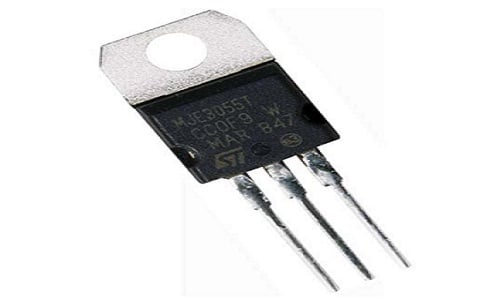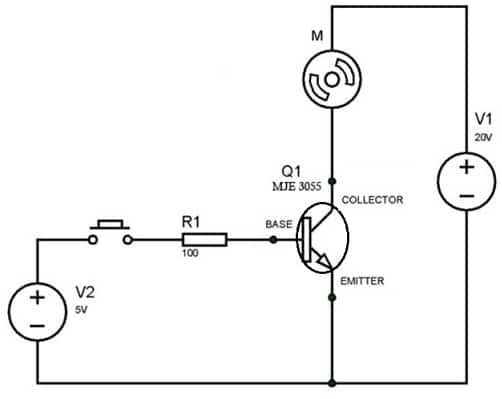A transistor is a fundamental semiconductor device used for switching and amplification in almost every electronic circuit. Among the various power transistors available today, the MJE3055 NPN power transistor is one of the most popular choices for medium to high-power applications such as motor control, audio amplifiers, and relay drivers. The MJE3055 transistor, housed in a TO-220 package, is a silicon NPN bipolar junction transistor (BJT) designed for general-purpose amplifier and power-switching applications. It offers high collector current (up to 10A), low saturation voltage, and excellent switching characteristics, making it ideal for circuits that demand efficient power handling and reliability.
The complementary PNP version of this transistor is the MJE2955, which is often used in push-pull amplifier configurations. Because of its 5V logic compatibility, the MJE3055 can be directly interfaced with popular microcontrollers like Arduino or PIC, allowing easy integration into control and automation systems. In this article, we’ll explore the MJE3055 NPN transistor pinout, features, specifications, equivalent transistors, and working circuit, along with its key advantages, limitations, and practical applications in real-world electronic systems.
Conclusion
What is MJE3055 NPN Transistor?
The MJE3055 is an NPN TO-220 package silicon epitaxial base transistor. This transistor is designed for use in general-purpose amplifiers & power-switching circuits. The complementary PNP-type transistor is MJE2955T. This NPN-type general-purpose power transistor is manufactured with the epitaxial base process & mounted within a TO-220 plastic package designed for efficient heat dissipation. The fast switching times & extremely low saturation voltage result in decreased switching & conduction losses.
This NPN transistor has a high collector current, so used in high-power switching circuits and also audio solenoids, amplifiers, pre-amplifiers, medium-power switching circuits, and relay control. This NPN-type transistor can also be driven directly by 5V logic levels from microcontrollers like PIC or Arduino.

MJE3055 NPN Transistor
While looking for a suitable transistor for your application based on a few factors, it is very important to look into a few points on How to Select a Transistor.
MJE3055 NPN Transistor Pin Configuration:
The pin configuration of the MJE3055 NPN transistor is shown below. This transistor includes three pins and every pin’s functionality is discussed below.

MJE3055 NPN Transistor PinOut
- Pin1 (Base): This base pin controls the transistor biasing.
- Pin2 (Collector): The collector pin collects the electrons from the emitter.
- Pin3 (Emitter): The emitter terminal emits electrons into the primary PN junction.
Features & Specifications:
The features and specifications of the MJE3055 NPN transistor include the following.
- MJE3055 is an NPN Bi-Polar power transistor.
- It is available within the TO-220 Package.
- It has Tin contact plating.
- The element material of the transistor is Silicon.
- The packaging type is a tube.
- It includes three pins.
- Its DC gain or hFE maximum is 100.
- Its continuous collector current or IC is 10Amps.
- Its emitter to base voltage or VBE is 5V.
- Its maximum base current or IB is 6A.
- Available in Pb−free packages.
- Its collector current or Ic is 10Amps.
- Its base current or Ib is 6A.
- Its maximum operating junction temperature or Tj is 150oC.
- Its storage temperature or Tstg ranges from -55 to 150oC.
- Its total power dissipation (Ptot) at Tc = 25°C is 75W.
- Its collector to base voltage maximum or |Vcb| is 70V.
- Its collector dissipation is 75W.
- Its transition frequency is 2 MHz.
- Its noise figure ranges from 2 to 10 dB.
- Its collector capacitance is 8.5pF.
- Maximum thermal resistance junction-case or Rthj is 1.66 oC/W.
- Its emitter to base voltage or VEBO is 5V.
- Its collector-to-emitter voltage or VCEO is 60V.
- Its collector-to-base voltage or VCBO is 70V.
- The mount type is Through Hole.
- Moisture Sensitivity Level or MSL is 1 (Unlimited).
- Its frequency is 2MHz.
- Its element configuration is single.
- The type of channel or polarity is NPN.
- Its transition frequency is 2MHz.
- Its minimum hFE is 20.
- Its Height x Length x Width = 9.15mm x 10.4mm x 4.6mm.
Equivalent and Complementary Transistors
Equivalent MJE3055 NPN transistors are; 2N6673, TIP122, 2N3055, MJE1101, MJE1103, MJE1102, MJE1123, MJE1290, MJE12007, MJE2955 & 2N6675. The complementary MJE3055T transistor is the MJE2955T PNP transistor.
Replacing a suitable transistor in any circuit based on requirement is very important. To know how to replace it, please refer to this; Replacing Transistors in Electronic Circuits: Factors and Considerations.
How to use MJE3055 NPN Transistor securely in a Circuit?
MJE3055 NPN Transistor can be used very securely in a circuit for a long time by following its specifications. Its emitter-to-base voltage must be 5V, collector-to-emitter voltage must be 60V, and collector-to-base voltage must be 70V. Its operating and storage temperature must range from -55 to 150oC.
MJE3055 NPN Transistor Circuit
MJE3055 NPN transistor circuit is shown below. This high-power-based application circuit is useful in controlling high-power loads like motors. The MJE3055T in this circuit is a versatile component that is used in different applications. The required components to make this circuit mainly include; R1- 100ohms resistor, MJE3055 NPN transistor, V1 – 20V, V2 – 5V, motor, and button. Connect the circuit using these components as per the diagram shown below.

MJE3055 NPN Transistor Circuit
The frequency range of the MJE3055 NPN transistor is quite limited, so it is used mostly in amplifiers, although it can be configured in some cases as a preamplifier mainly for a power amplifier stage.
The MJE3055T NPN transistor in this circuit is set in a CE configuration to drive a high-power-based load-like motor. The button in first circumstances will be in open circuit condition & no current will be supplied throughout the base terminal. The transistor works as an open circuit without base current & the entire voltage supply ‘V1’ will not emerge across it.
Connecting a base resistor to the base terminal of the transistor is mandatory to avoid it being damaged. Please refer to this link for; Choosing Base Resistance for Transistors in Electronic Circuits.
Working
Whenever the button in the circuit is pushed, the V2 voltage forms a closed loop through the BE of the transistor. Using a complete circuit, the flow of current throughout the BE terminals & the transistor will be turned ON. Once the button is released after a certain time, the current at the base terminal will become zero & the transistor will be shut down. When the transistor in the circuit goes to a higher resistance condition in OFF mode, then the current supply at the collector terminal also becomes zero so that the motor will stop rotating.
Tranistor can also be interface with microcontrollers for automations. Know how to interface a transistor with a microcontroller.
Advantages & Disadvantages
The advantages of the MJE3055 NPN transistor include the following.
- MJE3055 NPN is a versatile transistor that is used in different applications.
- This transistor handles more power, so used in high-power-based applications.
- It is a reliable transistor, used normally in general purpose & switching applications.
- This transistor is designed mainly to fit perfectly within different applications.
- This transistor uses silicon material because of its reliable semiconductor properties.
- These transistors have robustness.
The disadvantages of the MJE3055 NPN transistor include the following.
- This transistor is very sensitive to temperature.
- There are two drawbacks to the power handling capacity of a transistor; average junction temperature & breakdown.
- This transistor can produce heat particularly when they are closely packed together in ICs.
- These transistors can be liable to break from electrostatic discharge & voltage spikes.
- When these transistors continue to get smaller in size to enhance performance, then they become more vulnerable to quantum effects, so they can lead to reduced reliability & increased power leakage.
Applications
The applications of MJE3055 NPN transistors include the following.
- MJE3055 NPN transistor is designed to be used in general-purpose amplifiers & power-switching circuits.
- This transistor is used in amplifier circuits, regulator circuits, signal amplifiers, SMPS, PWM applications, etc.
- It is used in high-power switching circuits.
- The common applications of this transistor mainly include pre-amplifiers, audio amplifiers, relay control, and solenoid (or) medium power switching-based circuits.
- It can be used easily with different microcontrollers due to low control voltage.
Please refer to this link for the MJE3055 NPN Transistor Datasheet.
In summary, the MJE3055 NPN power transistor is a versatile and robust component that plays a crucial role in power amplification and switching circuits. Its 10A collector current, 60V collector-emitter voltage, and 75W power dissipation capacity make it suitable for controlling motors, solenoids, and other high-current loads efficiently.
With its low-voltage drive capability, the MJE3055 can be directly controlled by microcontrollers, making it ideal for Arduino-based motor drivers, PWM controllers, and relay circuits. When combined with its complementary PNP transistor, MJE2955, it can form push-pull amplifier stages or H-bridge driver circuits for bidirectional control.
Because of its stability, availability, and wide operating temperature range, the MJE3055 remains a preferred choice among engineers, students, and hobbyists for designing general-purpose power circuits.
If you’re selecting a power transistor for your project, the MJE3055 transistor datasheet provides detailed electrical characteristics, safe operating limits, and thermal design parameters to help ensure optimal circuit performance.